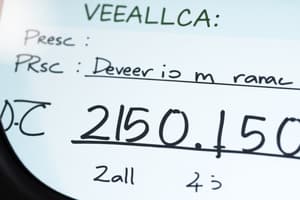Podcast
Questions and Answers
What does straight-line depreciation assume?
What does straight-line depreciation assume?
- The asset will lose more value in the early years
- The asset will lose an equal amount of value each year (correct)
- The asset's value will fluctuate year by year
- The asset will lose more value in the later years
How is the annual depreciation calculated in the straight-line depreciation method?
How is the annual depreciation calculated in the straight-line depreciation method?
- By subtracting the purchase price from the salvage value and dividing by the useful life
- By dividing the salvage value by the purchase price and the useful life
- By subtracting the salvage value from the purchase price and dividing by the useful life (correct)
- By dividing the purchase price by the salvage value and the useful life
What is accelerated depreciation?
What is accelerated depreciation?
- A method that allows a constant amount of depreciation throughout the property's useful life
- A method that allows a greater amount of depreciation in the early years of the property's useful life (correct)
- A method that allows a lesser amount of depreciation in the early years of the property's useful life
- A method that allows a greater amount of depreciation in the later years of the property's useful life
Which method allows for more depreciation in the early years of an asset's life?
Which method allows for more depreciation in the early years of an asset's life?
Flashcards
Straight-line depreciation assumption
Straight-line depreciation assumption
The assumption that an asset loses the same value each year of its useful life.
How to calculate straight-line depreciation
How to calculate straight-line depreciation
Subtract the salvage value from the purchase price and divide by the useful life.
Accelerated depreciation
Accelerated depreciation
A depreciation method where you take more depreciation expense in earlier years and less in later years.
Which method is faster early on?
Which method is faster early on?
Signup and view all the flashcards
Study Notes
Straight-Line Depreciation
- Straight-line depreciation assumes that an asset's value decreases at a constant rate over its useful life.
- It assumes that the asset's value decreases uniformly over time.
Calculating Annual Depreciation
- In the straight-line depreciation method, the annual depreciation is calculated by dividing the asset's cost minus its residual value by its useful life.
Accelerated Depreciation
- Accelerated depreciation is a method of depreciation that assumes an asset's value decreases more quickly in the early years of its life.
- It is used to reflect the fact that some assets lose more value in the early years of their use.
Comparison of Depreciation Methods
- Accelerated depreciation allows for more depreciation in the early years of an asset's life compared to straight-line depreciation.
- It provides a more rapid write-off of an asset's cost in the early years, resulting in higher depreciation expenses in the early years.
Studying That Suits You
Use AI to generate personalized quizzes and flashcards to suit your learning preferences.




